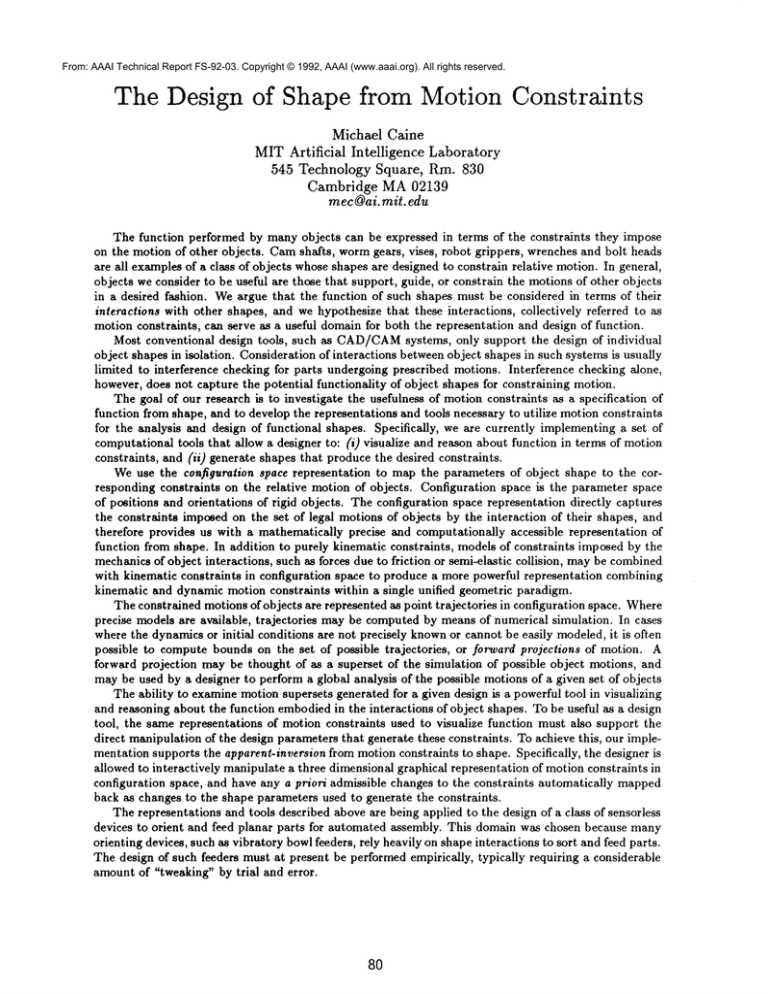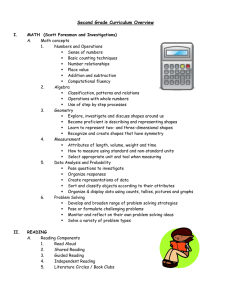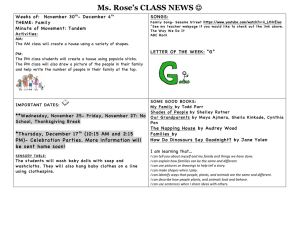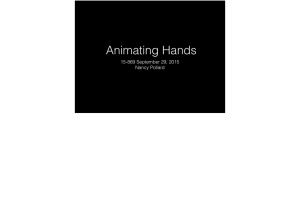
From: AAAI Technical Report FS-92-03. Copyright © 1992, AAAI (www.aaai.org). All rights reserved.
The Design of Shape from Motion Constraints
Michael Caine
MIT Artificial
Intelligence
Laboratory
545 Technology
Square, Rm. 830
Cambridge
MA 02139
mec@ai, mit. edu
The function performed by many objects can be expressed in terms of the constraints they impose
on the motion of other objects. Camshafts, wormgears, vises, robot grippers, wrenches and bolt heads
are all examplesof a class of objects whoseshapes are designed to constrain relative motion. In general,
objects we consider to be useful are those that support, guide, or constrain the motions of other objects
in a desired fashion. Weargue that the function of such shapes must be considered in terms of their
interactions with other shapes, and we hypothesize that these interactions, collectively referred to as
motion constraints, can serve as a useful domain for both the representation and design of function.
Most conventional design tools, such as CAD/CAM
systems, only support the design of individual
object shapes in isolation. Consideration of interactions between object shapes in such systems is usually
limited to interference checking for parts undergoing prescribed motions. Interference checking alone,
however, does not capture the potential functionality of object shapes for constraining motion.
The goal of our research is to investigate the usefulness of motion constraints as a specification of
function from shape, and to develop the representations and tools necessary to utilize motion constraints
for the analysis and design of functional shapes. Specifically, we are currently implementing a set of
computational tools that allow a designer to: (i) visualize and reason about function in terms of motion
constraints, and (ii) generate shapes that produce the desired constraints.
Weuse the configuration space representation to map the parameters of object shape to the corresponding constraints on the relative motion of objects. Configuration space is the parameter space
of positions and orientations of rigid objects. The configuration space representation directly captures
the constraints imposed on the set of legal motions of objects by the interaction of their shapes, and
therefore provides us with a mathematically precise and computationally accessible representation of
function from shape. In addition to purely kinematic constraints, models of constraints imposed by the
mechanicsof object interactions, such as forces due to friction or semi-elastic collision, maybe combined
with kinematic constraints in configuration space to produce a more powerful representation combining
kinematic and dynamic motion constraints within a single unified geometric paradigm.
The constrained motions of objects are represented as point trajectories in configuration space. Where
precise models are available, trajectories may be computed by means of numerical simulation. In cases
where the dynamics or initial conditions are not precisely knownor cannot be easily modeled, it is often
possible to compute bounds on the set of possible trajectories,
or forward projections of motion. A
forward projection may be thought of as a superset of the simulation of possible object motions, and
maybe used by a designer to perform a global analysis of the possible motions of a given set of objects
The ability to examine motion supersets generated for a given design is a powerful tool in visualizing
and reasoning about the function embodiedin the interactions of object shapes. To be useful as a design
tool, the same representations of motion constraints used to visualize function must also support the
direct manipulation of the design parameters that generate these constraints. To achieve this, our implementation supports the apparent-inversion from motion constraints to shape. Specifically, the designer is
allowed to interactively manipulate a three dimensional graphical representation of motion constraints in
configuration space, and have any a priori admissible changes to the constraints automatically mapped
back as changes to the shape parameters used to generate the constraints.
The representations and tools described above are being applied to the design of a class of sensorless
devices to orient and feed planar parts for automated assembly. This domain was chosen because many
orienting devices, such as vibratory bowl feeders, rely heavily on shape interactions to sort and feed parts.
The design of such feeders must at present be performed empirically, typically requiring a considerable
amount of "tweaking" by trial and error.
8O








